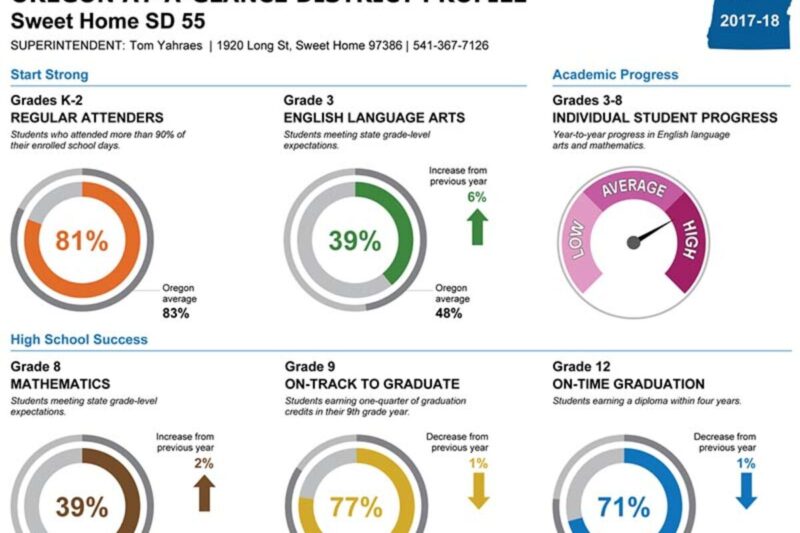Sean C. Morgan
The state’s report cards for schools and school districts may lack a letter grade again and undergone yet more changes this year, but they continue to contain the same information, which, this year, gives Sweet Home Supt. Tom Yahraes cause for optimism.
Students at Foster Elementary School have topped the district in terms of performance for many years after turning in some of the lowest ratings in academics in the district previously.
Holley School had relatively poor results two years ago, but last year joined Foster in terms of test performance.
In both cases, higher academic achievement ratings were preceded by high levels of academic growth.
“If we can replicate those models, we’ll be at the state average or exceeding (the state’s test standards),” Yahraes said.
That growth rating is listed as “high,” districtwide, in state school report cards released at the end of October by the Oregon Department of Education.
Most schools, including Foster and Holley, also ranked “high” for “individual student progress” year-to-year in language arts and math for the 2017-18 school year.
School report cards are to be distributed to each parent of a child enrolled in the district. They also are available at the Oregon Department of Education website.
The report card has changed from last year, based on the recommendation of a committee of parents and state education officials, Yahraes said. They came together to decide what a good report card looks like so the public can interpret it.
“It’s fairly strategic and interesting,” Yahraes said. The face of the report card highlights six different areas as indicators of a district’s performance, areas that indicate long-term success for students.
They include grades K-2 regular attendance, Grade Three language arts test results, Grade 3-8 individual student progress, Grade Eight math test results, Grade Nine students on track to graduate and Grade 12 on-time graduation.
In the first indicator, K-2 regular attendance, was 81 percent last year. The state average regular attendance was 83 percent. Regular attendance counts students who attend at least 90 percent of the time.
In the second, in Grade Three language arts, 39 percent of students met or exceeded the standard in state testing in 2017-18, an increase of 6 percent. Statewide, 48 percent met or exceeded the standard.
In the third, individual student progress was ranked high on a scale of low, average and high. “Average” is the level of improvement statewide, while “low” is below the statewide level of improvement and “high” is above the statewide level of improvement.
In the fourth, Grade Eight math, 39 percent of students met or exceeded the standard on state tests, an increase of 2 percent. Statewide, 41 percent met or exceeded the standard.
In the fifth, 77 percent of Grade Nine students were on track to graduate, a decrease of 1 percent from the year before. Statewide, 85 percent were on track to graduate.
In the sixth, 71 percent of seniors earned their diploma on time – within four years – a decrease of 1 percent from the year before. Statewide, 77 percent graduated on time.
The improvements in the first four drive the last two, Yahraes said, and the district improved in each of them.
“Third-grade language arts is a good predictor for future performance,” Yahraes said. Reading at grade level by the third grade is a foundation for other skills.
Likewise, Grade Eight math is a critical point in learning math skills, Yahraes said. Performance at that level is a strong indicator of success in math at the high school level where math is often the barrier to graduation for students.
“Our Junior High math department has really done a good job with our kids meeting or exceeding state standards,” Yahraes said, noting that Sweet Home is within two points of matching the state’s performance.
In year-to-year growth, Sweet Home’s schools are improving at a higher rate than the state average – the number of students meeting or exceeding state test standards is increasing at a faster rate than the rest of the state, Yahraes said. “If we continue on this positive trend, we will close the achievement gap for our kids.”
That’s what Foster School exemplified in the past, Yahraes said. “Foster’s growth has been on a positive trend line in closing the achievement gap.”
Now a good majority of Foster students are meeting or exceeding the state’s test standards, he said. He is looking for the same kind of gains districtwide, and the report indicates that Sweet Home is headed that direction.
The district isn’t banking on improvements in the lower grades to improve results at the high school level.
Freshmen on track to graduation are those who have earned a quarter of their required credits during their freshman year, Yahraes said. The district lost a percentage point in the rating as well as in on-time graduation.
Those two numbers have been fairly consistent in the past four years, Yahraes said. “We’re not waiting for these report cards to address these categories, as well as the regular attenders.”
High school staff have implemented lists of programs to help improve those numbers, Yahraes said. The new “care team” runs regular reports to track sophomore, juniors and seniors progress toward graduation.
When the team finds credit deficiencies, team members meet with the students and parents to address the circumstances of the deficiency.
The school also has a new “freshman focus” program designed to re-engage freshmen who are off track to graduate, Yahraes said.
Former counselor Jim Kistner is working directly with those students to solve credit deficiencies.
Measure 98 programs, funding approved by voters to improve graduation levels by boosting instruction in industrial and technical arts, has been used to further develop career and technical programming and reduce chronic absenteeism. Students are chronically absent when they miss more than 10 percent of school.
The district is working with the truancy officer to reduce absenteeism, Yahraes said, and last year, the high school implemented a tardy sweep program between classes, resulting in dramatic decreases in tardiness.
The district also has asked the Oregon Department of Education for an analysis of and feedback about Sweet Home High School programs, Yahraes said.
Overall, Yahraes is optimistic about Sweet Home based on the results in the report card.
“I’m very proud of our staff, our kids,” Yahraes said. “Our students are exceeding the state in terms of our academic growth. If we continue to we will be meeting or exceeding state standards.”
That will translate to higher graduation rates, Yahraes said.
“Overall, I’m very pleased,” Yahraes said. “However, our work is far from being complete.”
Highlights for individual schools – except the high school – included median class size, regular attenders, individual student progress, language arts, math and science.
Sweet Home Junior High
At Sweet Home Junior High, median class size decreased by three to 23.
Regular attenders increased by 1 percent to 73 percent of students. Statewide, 80 percent of students were regular attenders.
Individual student progress in math and language arts was average, matching the level of growth statewide.
Some 46 percent of students met or exceeded language arts standards, up 1 percent from the previous year. Statewide, 57 percent met or exceeded the standard.
In math, 34 percent met or exceeded the standard, a decrease of 5 percent. Statewide, 42 percent met or exceeded the standard.
In science, 64 percent met or exceeded the standard, an increase of 8 percent. Statewide, 61 percent met or exceeded the standard.
Sweet Home Charter School
At Sweet Home Charter School, median class size remained 16.
Regular attenders increased by 12 percent to 85 percent of students. Statewide, 80 percent of students were regular attenders.
Individual student progress in math and language arts was high, exceeding the level of growth statewide.
In language arts, 52 percent of students met or exceeded language arts standards, no change from the previous year. Statewide, 52 percent met or exceeded the standard.
In math, 49 percent met or exceeded the standard, an increase of 1 percent. Statewide, 43 percent met or exceeded the standard.
In science, 79 percent met or exceeded the standard, a decrease of 2 percent. Statewide, 65 percent met or exceeded the standard.
Oak Heights Elementary
At Oak Heights Elementary, median class size decreased by four students to 24 per class.
Regular attenders remained unchanged at 80 percent of students. Statewide, 80 percent of students were regular attenders.
Individual student progress in math and language arts was high in the average range, nearly “high,” on the higher side of the level of growth statewide.
In language arts, 31 percent of students met or exceeded language arts standards, an increase of 1 percent from the prior year. Statewide, 52 percent met or exceeded the standard.
In math, 22 percent met or exceeded the standard, a decrease of 7 percent. Statewide, 43 percent met or exceeded the standard.
In science, 51 percent met or exceeded the standard, a decrease of 13 percent. Statewide, 65 percent met or exceeded the standard.
Holley Elementary
At Holley Elementary, median class size increased by two to 22 students per class.
Regular attenders fell by 6 percent to 81 percent of students. Statewide, 80 percent of students were regular attenders.
Individual student progress in math and language arts was high, exceeding the level of growth statewide.
In language arts, 47 percent of students met or exceeded language arts standards, an increase of 17 percent from the previous year. Statewide, 52 percent met or exceeded the standard.
In math, 29 percent met or exceeded the standard, an increase of 8 percent. Statewide, 43 percent met or exceeded the standard.
In science, 74 percent met or exceeded the standard, an increase of 14 percent. Statewide, 65 percent met or exceeded the standard.
Hawthorne Elementary
At Hawthorne Elementary, median class size increased by one to 24 students per class.
Regular attenders increased by 5 percent to 89 percent of students. Statewide, 80 percent of students were regular attenders.
Individual student progress in math and language arts was high, exceeding the level of growth statewide.
In language arts, 43 percent of students met or exceeded language arts standards, an increase of 3 percent from the prior year. Statewide, 52 percent met or exceeded the standard.
In math, 33 percent met or exceeded the standard, a decrease of 2 percent. Statewide, 43 percent met or exceeded the standard.
In science, 73 percent met or exceeded the standard, an increase of 14 percent. Statewide, 65 percent met or exceeded the standard.
Foster Elementary
At Foster Elementary, median class size increased by one to 25 students per class.
Regular attenders increased by 7 percent to 84 percent of students. Statewide, 80 percent of students were regular attenders.
Individual student progress in math and language arts was high, exceeding the level of growth statewide.
In language arts, 52 percent of students met or exceeded language arts standards, an increase of 12 percent from the prior year. Statewide, 52 percent met or exceeded the standard.
In math, 46 percent met or exceeded the standard, an increase of 8 percent. Statewide, 43 percent met or exceeded the standard.
In science, 57 percent met or exceeded the standard, a decrease of 13 percent. Statewide, 65 percent met or exceeded the standard.
Sweet Home High School
At Sweet Home High School, median class size was 25, an increase of two students per class.
Regular attenders were unchaged at 61 percent of students. Statewide, 80 percent of students were regular attenders.
Individual student progress in math and language arts was high, exceeding the level of growth statewide.
On track to graduate was at 77 percent of freshmen, down 1 percent from the year prior. The statewide average was 85 percent.
On-time graduation was 71 percent, down one point from the year prior. The statewide average was 77 percent.
The five-year completion rate was 81 percent, an increase of 5 percent and just shy of the statewide average of 83 percent.





